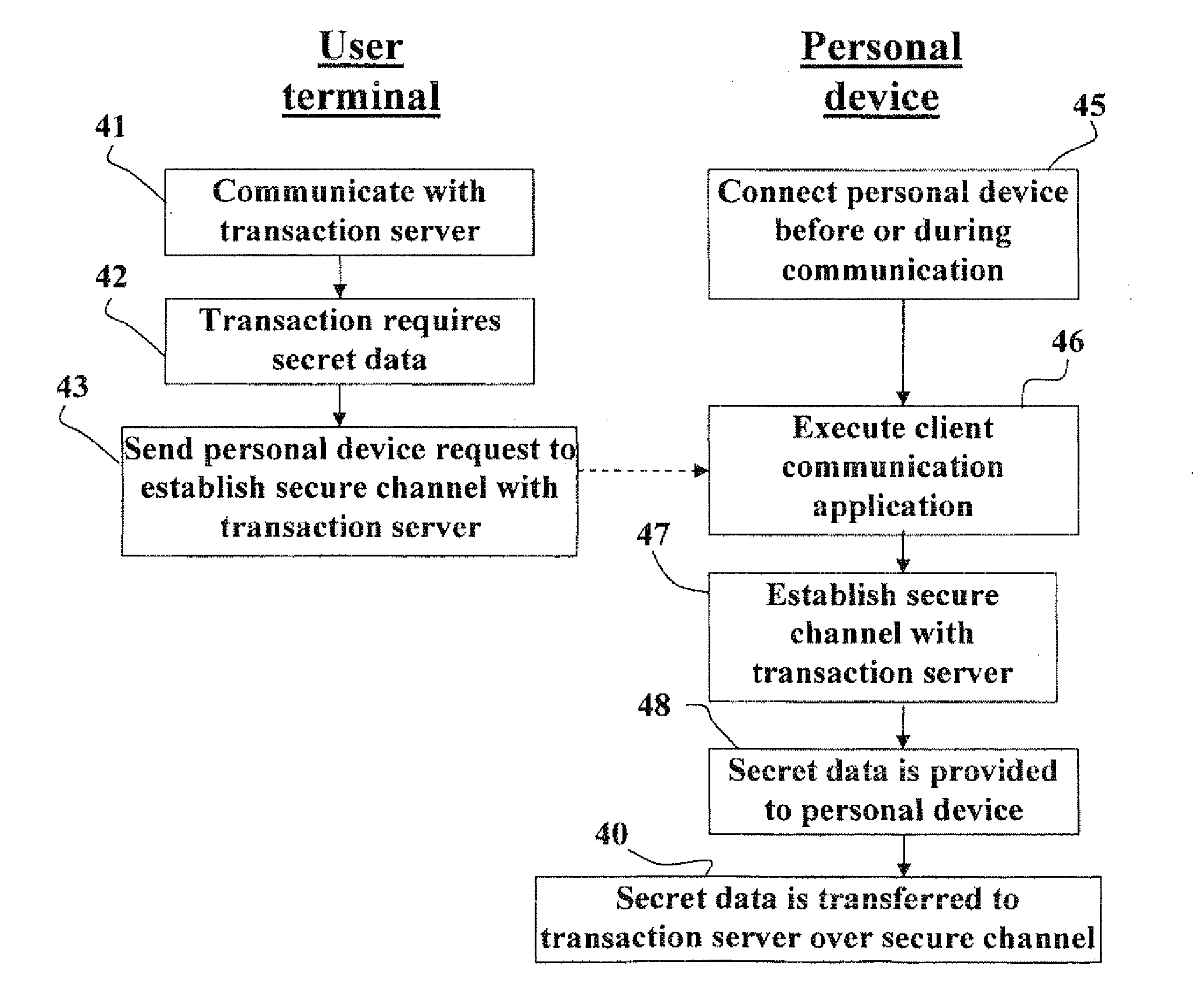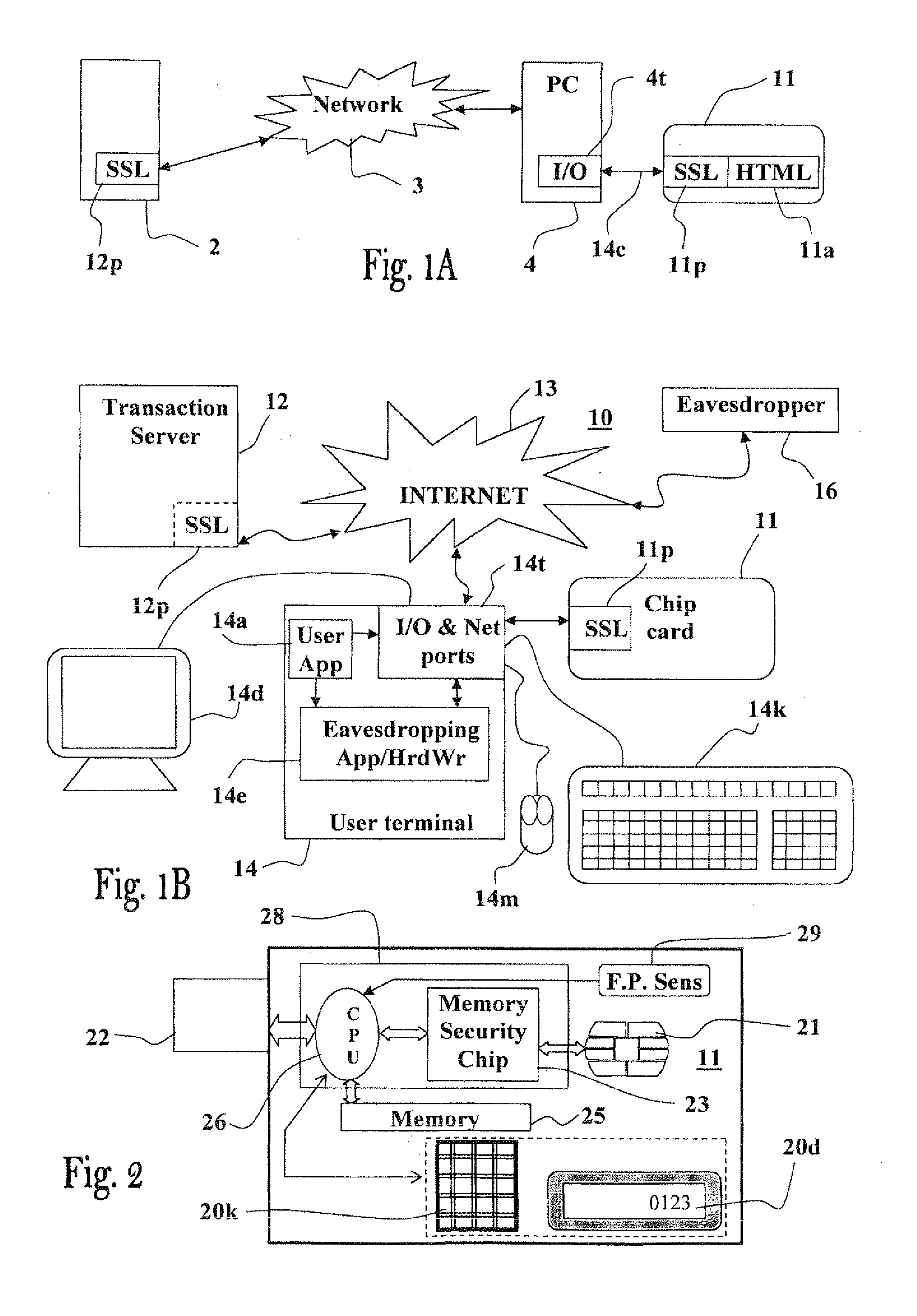[0010]The inventors of the present invention developed new methods and apparatus for securely carrying out electronic communication over conventional data networks, such as
the Internet, by means of insecure computer terminals. The present invention significantly increase the security of the electronic communication carried out and provides tamper-proof and eavesdrop-proof communication between the communicating parties (e.g., user's PC
machine and a
service provider's server, or PC
machine of another user, which are generally related to herein as a
computer terminal), which prevents any attempt to intercept, tamper with, or copy the information transferred between the communicating parties and any external intervention. The present invention may be advantageously used for carrying out electronic transactions (e.g., bank transactions, e-commerce, any transfer of confidential information between communicating parties over a data network).
[0015]In a specific preferred embodiment of the invention the communication between the communicating parties is established by the personal apparatus by means of a networking software module installed in the computer terminal, or uploaded thereto from the personal apparatus upon connection. This networking software module is designed to identify the personal apparatus once it is connected to the computer terminal and provide it access to network resources of the computer terminal. The apparatus can authenticate (for example—by using PKI digital signatures or suitable protocols, such as the SSL protocol) the computer used by the other communicating party (e.g., bank server), and optionally the computer used by said communicating party can similarly authenticate the personal apparatus. In this way communication with wrong parties (e.g., impersonators), which may occur when an erroneous
network address is typed by the user, is prevented.
[0020]According to another preferred embodiment of the invention the electronic communication is securely carried out between the user's computer terminal and the communicating party by means of graphical presentation of the information involved in the communication. More particularly, instead of transferring the information in the conventional way by means
alphanumeric text symbols, images are generated by the communicating parties graphically incorporating the information in an OCR resistant form (in a machine non-readable form, such as in
CAPTCHA challenges). In this way the information transferred by the communicating parties by means of such graphical representations remains concealed against eavesdropping threats.
[0021]According to yet another preferred embodiment of the invention the electronic communication is securely carried out between the user, using standard I / O means of the computer terminal, such as keyboard, mouse and display of the user's computer terminal, and the personal apparatus by means of graphical presentation of the information involved in the communication. More particularly, instead of transferring the information in the conventional way by means of
alphanumeric text symbols typed by the user by means of a keyboard of the computer terminal,
data entry images are generated by the apparatus graphically incorporating the information in an OCR resistant form (in a machine non-readable form, such as in
CAPTCHA challenges). Inputs from the user to the auxiliary apparatus can be provided by pointing and clicking on the graphic images displayed on the screen—including
alphanumeric and or graphic symbols images presented by graphic techniques - in this way the information transferred by the user to the auxiliary apparatus by indicating the relative locations in the displayed image over which the user “clicked” the
pointing device. The auxiliary device, or the other communicating party, may then extract the secret information provided by the user using the information of the “clicked” locations, such that the secret information transferred by the user remains concealed against eavesdropping threats.
[0024]Images may be further used for displaying the user possible options by incorporating into them graphical OCR proof textual representations of the options and allowing the user to perform graphical selection of the needed operation simply by “clicking” over the selected option in the image with a
pointing device of the computer terminal. In a similar fashion, only the relative locations in the displayed image over which the user “clicked” the
pointing device are transferred to the auxiliary apparatus over the I / O port, and / or to the other communicating party over the data network, such that the user's selection remains concealed against eavesdropping.
 Login to View More
Login to View More  Login to View More
Login to View More 


